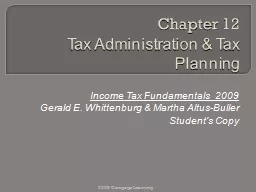

Income Tax Fundamentals 2009 Gerald E Whittenburg amp Martha Altus Buller Students Copy 2009 Cengage Learning Internal Revenue Service IRS Congress creates tax law and the IRS enforces it ID: 655587
Download Presentation The PPT/PDF document "Chapter 12 Tax Administration & Tax ..." is the property of its rightful owner. Permission is granted to download and print the materials on this web site for personal, non-commercial use only, and to display it on your personal computer provided you do not modify the materials and that you retain all copyright notices contained in the materials. By downloading content from our website, you accept the terms of this agreement.
Slide1
Chapter 12Tax Administration & Tax Planning
Income Tax Fundamentals 2009 Gerald E. Whittenburg & Martha Altus-BullerStudent’s Copy
2009 Cengage LearningSlide2
Internal Revenue Service [IRS]
Congress creates tax law and the IRS enforces it.Includes assessment and collection departmentsIs a branch of the Treasury DepartmentIs headquartered in Washington DCCommissioner of IRS is appointed by President and approved by Congress2009 Cengage LearningSlide3
IRS Restructuring Act of 1998
This act sought to structurally and operationally change the IRS by creating operating units that serve particular groups of like-kind taxpayersCreated independent Oversight BoardCreated independent National Taxpayer AdvocateTerm of IRS Commissioner limited to five years2009 Cengage LearningSlide4
Examination of Records
IRS has authority to examine taxpayers’ accounting records and books in a process called an auditIRS can summon taxpayers and require them to appear before the IRS and produce necessary accounting recordsIRS may also summon taxpayer records from third parties [CPAs, brokers, etc.]Taxpayer should enlist professional tax advice2009 Cengage LearningSlide5
Appeals Process
When tax return is selected for examination, an agent is assigned to audit There are three possible resultsAgent determines that there are no changesAgent and taxpayer agree that there is a change in tax liabilityAgent and taxpayer disagree on outcomeIn this scenario, taxpayer may appeal through established appeals proceduresSee Figures 2 and 3 on pp. 12-6 – 12-72009 Cengage LearningSlide6
Interest
Interest is charged to taxpayer for late taxes For example, prior year audit reveals tax due Interest paid is nondeductible consumer interestInterest is paid to the taxpayer for refund Prior year audit reveals refund dueInterest received from IRS is incomeInterest rate is adjusted quarterly based on the short-term federal rate plus 3 percentage pointsSample of recent rates:1st quarter 2008 7%2nd quarter 2008 6%3
rd
quarter 2008 5%
4
th
quarter 2008 6%
2009 Cengage LearningSlide7
Statute of Limitations
A taxpayer may not amend, nor may the IRS assess additional taxes, on a tax return for which the three year statute of limitations has expired - generally this is three years from due dateExceptionsNo statute of limitations if it is a fraudulent tax returnBecomes six years if amount of gross income omitted exceeds 25% of total gross incomeStatute of limitations for deduction of a bad debt or worthless security is seven years2009 Cengage LearningSlide8
Tax Practitioners
The IRS does not prescribe any minimum level of education for tax preparationOnly CPAs, attorneys or enrolled agents may represent clients at IRS proceedingsThere are a multitude of preparer penalties For example, if tax preparer does not exercise due diligence, tax returns are not signed, or copy is not provided to clients, the tax preparer may be assessed a penalty2009 Cengage LearningSlide9
Burden of Proof
Historically, IRS placed burden of proof on taxpayer in most civil tax casesIRS Restructuring & Reform Act of 1998 changed tax law to shift burden of proof to IRS in many casesWhen corporation, trust or partnership has net worth > $7 million, burden of proof rests with taxpayerBurden of proof automatically shifts to IRS in two situationsIRS uses statistics to reconstruct an individual’s incomeCourt proceeding against an individual taxpayer involves penalty/addition to tax2009 Cengage LearningSlide10
Taxpayer Bill of Rights
Document addresses taxpayers rights Requires the IRS to inform taxpayers of their rights when dealing with the ServiceIt provides remedies for resolving disputes with the IRSPart I – Declaration of Taxpayer RightsDirects taxpayer to other IRS publications for more detailsPart II –Examinations, Appeals, Collections & RefundsSee pp. 12-17 – 12-182009 Cengage Learning